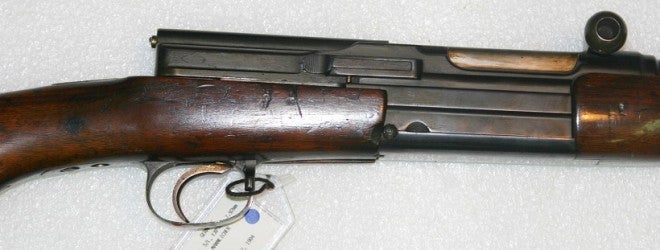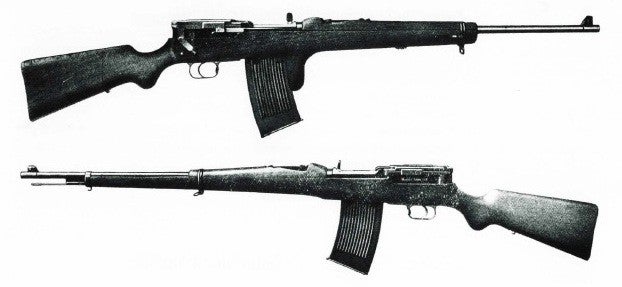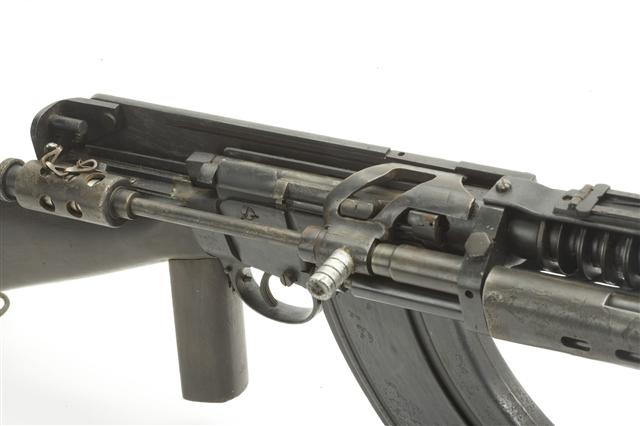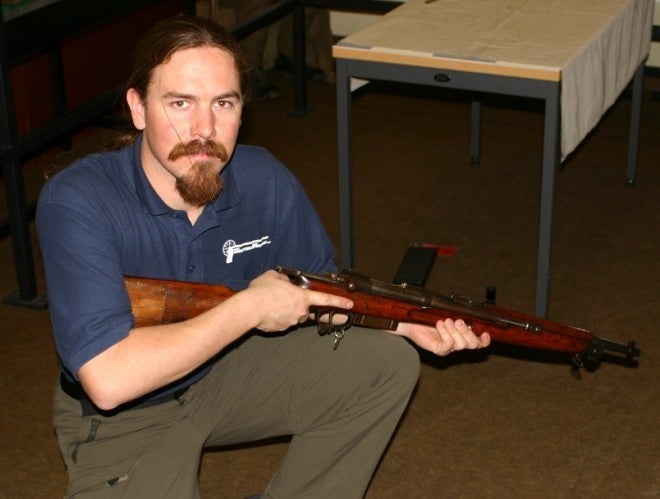Semiauto rifles are taken for granted today – every military in the world uses them, they are the mainstay of many types of competition, most police forces, and a great many hunters. And yet, the self-loading rifle in a full size military cartridge only became common a fairly short time ago. When World War II broke out, only the US actually had such a rifle as the standard infantry arm, and many nations didn’t make the switch until the 1950s.
Of course, self-loading rifles were being developed well over a hundred years ago, and I think some of the early ones are very interesting guns. So why don’t we take a look at some of those early designs?
Remington Model 8
Considering his creativity and omnipresence in firearms design, it should come as no surprise that John Moses Browning developed a self-loading rifle very early – he had a patent granted in 1900 that would become the Remington Model 8 rifle. The Model 8 came on the market in 1906, and built itself a reputation as a reliable, durable, and somewhat awkward hunter’s weapon. It was available in four calibers; .25, .30, .32, and .35 Remington, and all of these were respectably powerful rounds, pushing bullets at around 2100 fps and generating up to 2100 ftlb of energy. So far, this sounds like a pretty decent military arm – but we’re getting to the problems. The Model 8 used a long-recoil operating system (same type as the infamous French Chauchat LMG), which was just fine for hunting but prone to overheating and malfunctioning with high volumes of shooting. The Model 8 also used a fixed 5-round single stack magazine, which was not well suited to military use.

Remington Model 8
The Model 8 was fairly front-heavy as it was, and beefing it up for military service would have made the weight unacceptable. The single-stack magazine also was less than ideal for military use – the extended magazines made for police use were much too long to be acceptable to a military. Remington likely saw these issues, and realized that the chances of adapting a successful military version were much too slim to justify the R&D expense that would be involved.
Winchester 1905/07/10
Winchester produced a series of self-loading sporting rifles to compete with the Remington Model 8. Where the Remington was a clever and complex design, the Winchester approach was basically one of brute force. The Winchester rifles were chambered for .32 and .35 caliber straight-walled rounds which developed much less velocity than the Remington line – around 1400fps (although the Winchester 1907 was used the larger .351 Winchester round, and the 1910 model the even larger .401 Winchester round). By using lower powered ammunition, Winchester was able to design the 1905 as a simple blowback action, using a large weight inside the handguard fixed to the bolt.

Winchester Model 1905
The Winchester self-loaders were relatively inexpensive, and effective sporting arms. The blowback mechanism was stretched to its practical limits in the .401 caliber 1910 model, and the rifle could never have been adapted to the military .30-06 cartridge, thus preventing any chance at a military model.
Cei-Rigotti
One of the earliest semiauto rifles developed was the brainchild of an Italian Bersaglieri (light infantry) Major named Amerigo Cei-Rigotti. The rifle that came to be known simply by his name is also one of the more ergonomically practical of the early self-loaders – it is short, light, and comfortable to handle. Although it was made from scratch, the Cei-Rigotti design uses the common bolt action as a starting point. It uses a receiver and bolt design from a Carcano, and uses a short-stroke gas piston under the barrel in conjunction a cam to open and close the bolt. The distinctive tube on the right side of the weapon is actually just a charging handle and recoil spring guide.

Cei-Rigotti
The Cei Rigotti was tested by number of European military forces, and adopted by none. Unfortunately, the only testing report that has come to light is from a British test, which noted major reliability problems. It also noted that the ammunition used for the test was seriously damaged in transit, which leaves us to wonder how the rifle would have fared if tested with proper ammunition. On a larger note, it is surprising how often experimental military arms fail testing because of obviously bad ammunition…
Meunier A6
The French military was on the cutting edge of firearms development at this time, and had a pretty serious R&D program working on self-loading rifles. After a series of trials, the Meunier A6 emerged as a remarkably advanced and effective design. Like the Remington Model 8, the A6 used a long-recoil mechanism and a rotating bolt. It also used an excellent 7mm rimless cartridge instead of the then-standard 8mm Lebel round. The Lebel cartridge was rimmed and heavily tapered – good for its time, but rendered obsolete by new developments and not ideal for self-loading designs.

Meunier A6
The Meunier A6 was actually put into production in 1913, but the impending war led to its abandonment in the name of logistics. It was simply impossible to reequip the army with new modern rifles in a short time, and maintaining two different infantry rifle cartridges would have been a strain on the supply chain. Had World War I not intervened, France likely would have become the first major military power to adopt a self-loading rifle, and it would have been the Meunier A6.
RSC Model 1917/1918
Despite the formal French self-loading rifle trials being dropped as WWI approached, interest in repeating rifles persisted. During the war, a team of French engineers (Ribeyrolles, Sutter, and Chauchat) designed a rifle in 8mm Lebel that they proceeded to pitch to the government as a conversion kit for the standard 1886 Lebel rifle. The idea of way to convert older bolt action rifles into modern self-loaders was of course quite appealing, and since they would use the same ammunition, logistical issues would be (theoretically) much simpler.

RSC Model 1917
However, the “conversion kit” talk was…how shall we say it? Mostly marketing. It truth, the buttstock was pretty much the only part of a Lebel that could be used in an RSC Model 1917 rifle. Still, it was enough to get a foot in the door, so to speak, and more than 85,000 of the guns were made before the end of hostilities (mostly the original 1917 model, but late in the war an improved 1918 model rifle and shortened carbine also went into production). This would prove to be the most-produced self-loading rifle of the First World War, although its performance left a lot to be desired. Ironically, logistics still turned out to be an issue, as the RSC used a 5-round clip that was not interchangeable with the 5-round clips for the M1916 Berthier rifles that were being developed at the same time. After the war, the rifles were mostly sent out to colonial forces, and it would be 1940 before France finally adopted a self-loading rifle (and 1949 before they really perfected it).
Farquhar-Hill
The Farquhar-Hill was a British design initially patented in 1908, although it went through a major revision in 1915. In its final iteration, it used a unique double-piston gas operating system. In a nutshell, gas was tapped form the barrel and then used to push a spring loaded piston. When the front end of that piston was pushed all the way back, it would lock in place and the rear end would be released, which was connected to the bolt and bolt carrier. The rationale for this system was so that in the case of an over-pressure round, the piston would still stop at the same place and the excess gas would just vent out the barrel. Thus the spring pressure operating the bolt would remain consistent, and the gun would be more reliable.

Farquhar-Hill
In practice, however, the whole mechanism proved too delicate for general infantry use. The British Army rejected it, although the Royal Flying Corps (predecessor to the RAF) did make some use of them, as aircraft use was much cleaner than the trenches, and the semiauto action much more of advantage in aerial combat. The Farquhar-Hill’s 19-round drum magazine (using standard .303 British ammunition) was another advantage for aerial use. When shooting the Farquhar-Hill, a slight delay in operation is noticeable, because of the front of the piston has to finish moving before the bolt begins to travel. It is a very pleasant rifle to shoot, although a bit heavy.
Liu
General Liu was a Chinese officer and firearms designer who developed a rifle based on the Danish Bang system for use by the Chinese Army during the 1910s. The Bang system was the design initially seen as most promising by US Ordnance officers as well, and it led to the gas trap system of the early M1 Garand and the German G41 rifles. Basically, a cup was placed just past the muzzle of the rifle, with a bullet-sized hole in it. This cup was connected by a long rod and a lever to the bolt carrier. When the rifle was fired, the muzzle cup would catch the muzzle blast and be pulled forward, and the connecting rod would transfer this inertia to the bolt. Testing of Liu’s design in China was successful enough that he travelled to the US, and contracted with Colt to produce an initial series of rifles and all the tooling necessary to mass produce them in China.

General Liu’s rifle
The contract was fulfilled, but unfortunately Liu died while en route back to China, and the program fell apart without his leadership. The machinery was left on the docks after its arrival, and years later what could be salvaged from neglect was modified to be used building ZB-26 light machine guns instead.
While the Bang system seemed pretty good to Ordnance men in the 1910s, it proved flawed under extended tests. All of the rifles of this basic type ever made have suffered from reliability problems, as the muzzle gasses deposit fouling on the moving parts and eventually gun them up to the point of failure. One should note that the final iteration of the M1 Garand in fact abandoned the system, using a gas port in the barrel instead.
Luger Model 1906
Even before his adaptation of the Borchardt pistol had been adopted by the German Army, Georg Luger had built a couple experimental versions of a military rifle using the same toggle action. Not much is known about the rifle’s performance, as it was never put into production and the reports from any testing are lost. If I was forced to guess, I would wager that the rifle had extraction problems, as the toggle system does not work very well in a shoulder rifle with high-pressure ammunition. The Pedersen rifle developed in the US had this sort of trouble, which was addressed by using wax-coated ammunition (a major factor in its loss to the Garand for US service use).

Luger Model 1906
Madsen-Rasmussen 1896
The Madsen-Rasmussen has the honor of being the first self-loading rifle to be adopted by a formal military force, as the Danish Marines purchased a batch of 60 of them for their harbor fortresses after successful trials in 1896. The design process began in 1883, and the Madsen system is a unique and complex one. It is most easily described as a falling block system, as the bolt is pinned to the receiver at the back, and pivots up and down like a Martini-Henry as it cycles. The system saw real success as the model 1902 Madsen light machine gun (which saw service worldwide and remains in sporadic use even today), and the rifle design was mechanically very similar. It was a short recoil system, and used a top-feeding magazine (the early and unsuccessful 1888 version actually used a gravity-fed exposed stack of cartridges rather like a Gatling gun’s Bruce feed stick).

Madsen-Rasmussen M1896
The Madsen-Rasmussen was testing internationally (including in the US), but not adopted elsewhere as a self-loading rifle. The designers saw the writing on the wall, and are to be commended for making it into a very successful light machine gun. In that form, a much greater overall weight was acceptable, and this allowed them to make larger and more robust parts. Whether the system could ever have been made light enough for a shoulder rifle while retaining military-grade reliability is doubtful.
Mannlicher 1905
Ferdinand von Mannlicher was another prominent firearms designer in Austria at the time, having invented a series of successful automatic pistols. He also made an attempt to win a military contract, with a model 1905 self-loading rifle. As with the Luger self-loader, testing reports are unavailable and only a few of the guns were ever made. The design is a short-recoil action with a tiling locking block – basically his 1901 pistol-caliber carbine scaled up to 8mm Mauser.

Mannlicher 1905 action (photo courtesy NFC, Leeds, UK)
It is possible that this design could have been made into something successful, but von Mannlicher died in 1904 and it wasn’t pursued any further. In fact, the patent on the design was actually issued after his death.
Mauser M1916
As the designers of the wildly popular and successful series of bolt action rifles, the Mauser brothers could be sure that any semi-automatic rifle they designed would be given consideration by military forces worldwide. Paul Mauser spend many years working on self-loading rifles (and lost an eye to an out-of-battery detonation in one of his early prototypes). After experimenting with several different systems, he settled on a delayed blowback system which was adopted by German the German airship corps in 1915 and the German fixed-wing air corps in 1916. Like most of its contemporaries, it was a delicate mechanism that would only function reliably when quite clean. As a result, it was unsuitable for ground infantry use, but the clean aircraft environment and the advantage of rapid fire there gave it a brief window of service use in early WWI.

Mauser M1916
The Mauser was a quite accurate rifle, but it was very expensive to manufacture. It was generally replaced in service by Mondragon rifles purchased from Switzerland, which were less accurate and less reliable, but significantly less expensive. Of course, those Mondragons were subsequently replaced by carious machine guns as aircraft armaments became more sophisticated.
Mondragon 1907
Mexican President Porfirio Diaz was an avid firearms enthusiast, and his administration encouraged development in firearms, including work by an Army officer named Manuel Mondragon. Mondragon worked in Switzerland for some time and developed a number of different firearms, although he is best known for his 1907 model self-loading rifle. This weapon was adopted by the Mexican Army in 1908, chambered for 7x57mm Mauser ammunition. Mechanically, the rifle uses a gas piston and a rotating bolt, along with detachable box magazines. It also includes a feature that was fairly common at the time due to concerns about troops wasting ammunition – a gas cutoff. This allows the gas port to be closed off, effectively making the rifle into a straight-pull bolt action. Doctrine intended that soldiers would only switch to semiautomatic operation in emergency circumstances, and would normally operate the rifle manually to artificially reduce their rate of fire and save ammunition. Needless to say, as semiauto rifles started to see actual combat use, this notion was quickly abandoned.

Mondragon 1907 with drum magazine
Mexico ordered 4000 Mondragon rifles, which were being manufactured by SIG. They ignored SIG’s warning that the system would not work well with low quality ammunition (which described most of what was available in Mexico at the time), and the Mexican government cancelled the order after just one thousand rifles were delivered when they discovered this problem firsthand. The remaining 3000 rifles ended up beign sold to Germany during WWI, where they were used as aircraft armament until aerial machine guns became commonplace.
Bolt Action Conversions
Of course, one thing every military force was interested in was a way to convert existing bolt action rifles into self-loaders. Everyone had large quantities of bolt guns, and being able to reuse them would offer a significant monetary savings over adoption of a wholly new rifle. The opportunity to win a lucrative military contract led inventors and tinkerers worldwide to try their hands at this problem, and many experimental conversions were built. All were ultimately unsuccessful, and information is generally very hard to come by on them as a result.

Charlton conversion
The most common method to make such a conversion was to add a gas port to the front of the rifle, and slap a gas piston onto the side of the stock. The bolt handle would be cut off, and replaced with a camming plate on the end of the gas piston, so that rearward movement of the piston would rotate the bolt to unlock it and then open it. A return spring would around the gas piston would close and lock the bolt by the same path in reverse. The conversion was simplified for the countries (like Austria) which had adopted straight-pull rifles, as the camming system didn’t have to be added. The most successful example of this mechanism was the Charlton LMG built out of Lee Metford rifles in New Zealand early in WWII, but even those were quickly relegated to reserve use and never saw combat.
Others
We have barely scratched the surface here – virtually every country with a firearms industry had inventors working on semiautomatic rifles in the early years of the 20th century. The US alone looked as dozens before finally adopting the Garand rifle. Do you have a favorite one that I didn’t mention? Tell me in the comments!
 Your Privacy Choices
Your Privacy Choices
